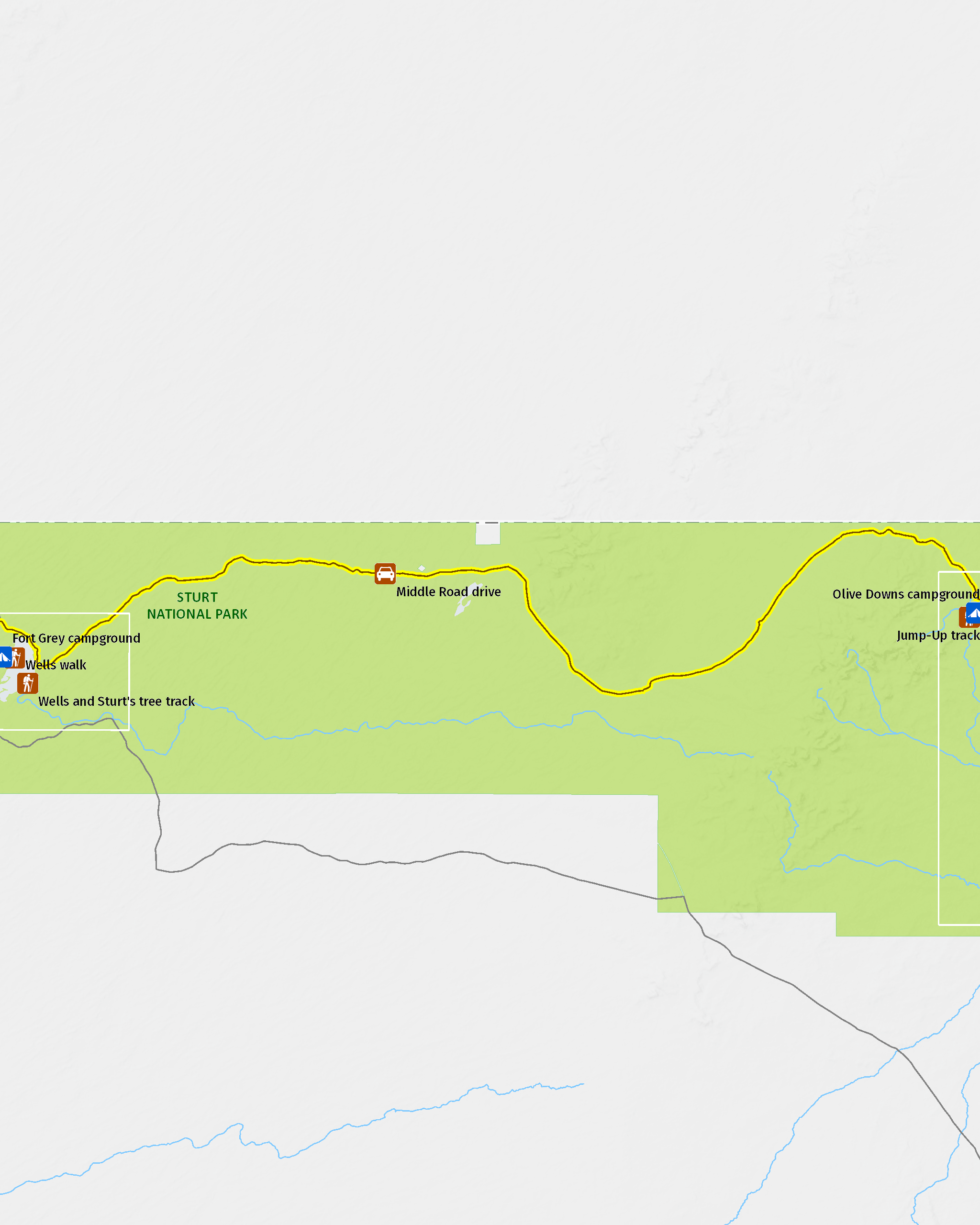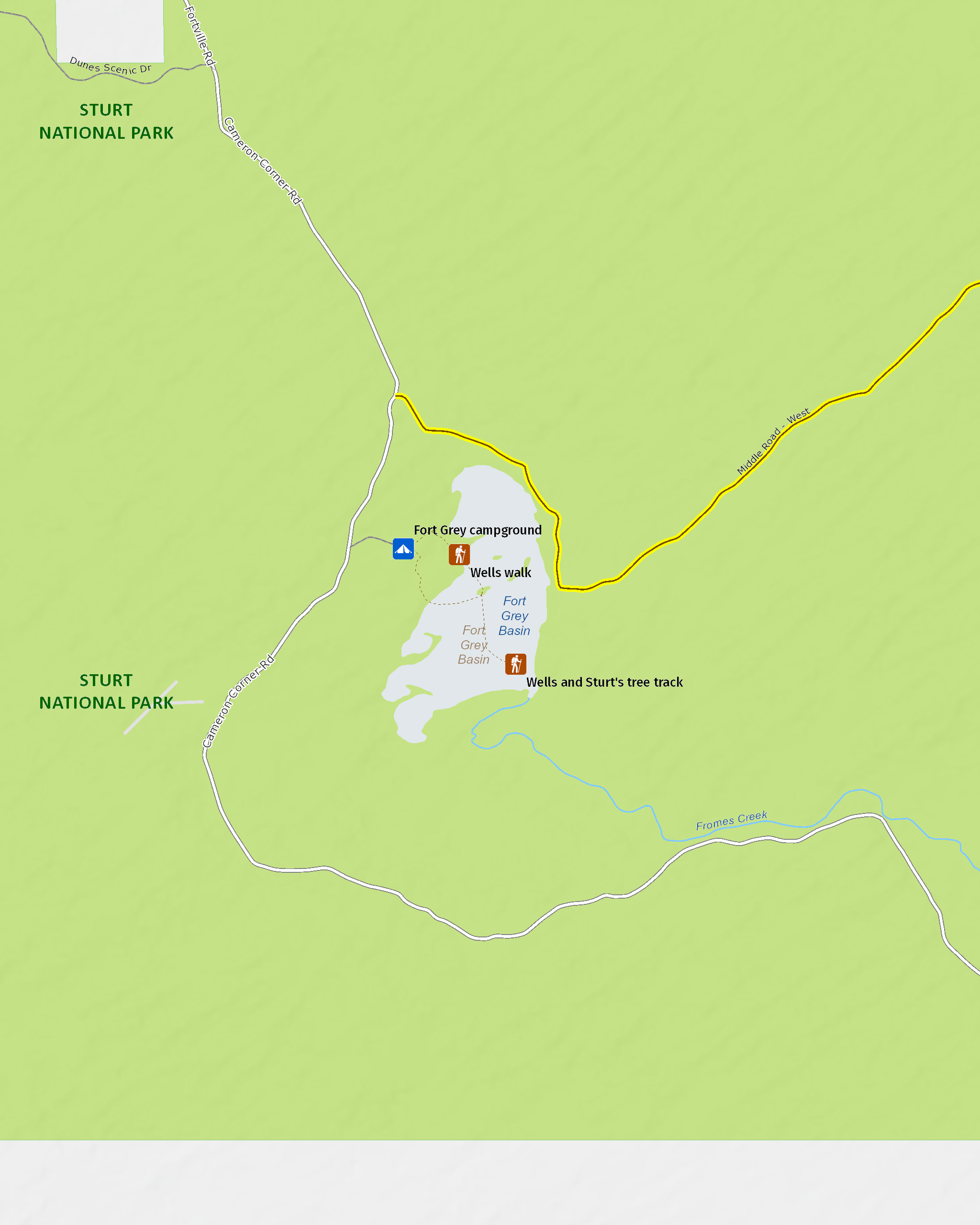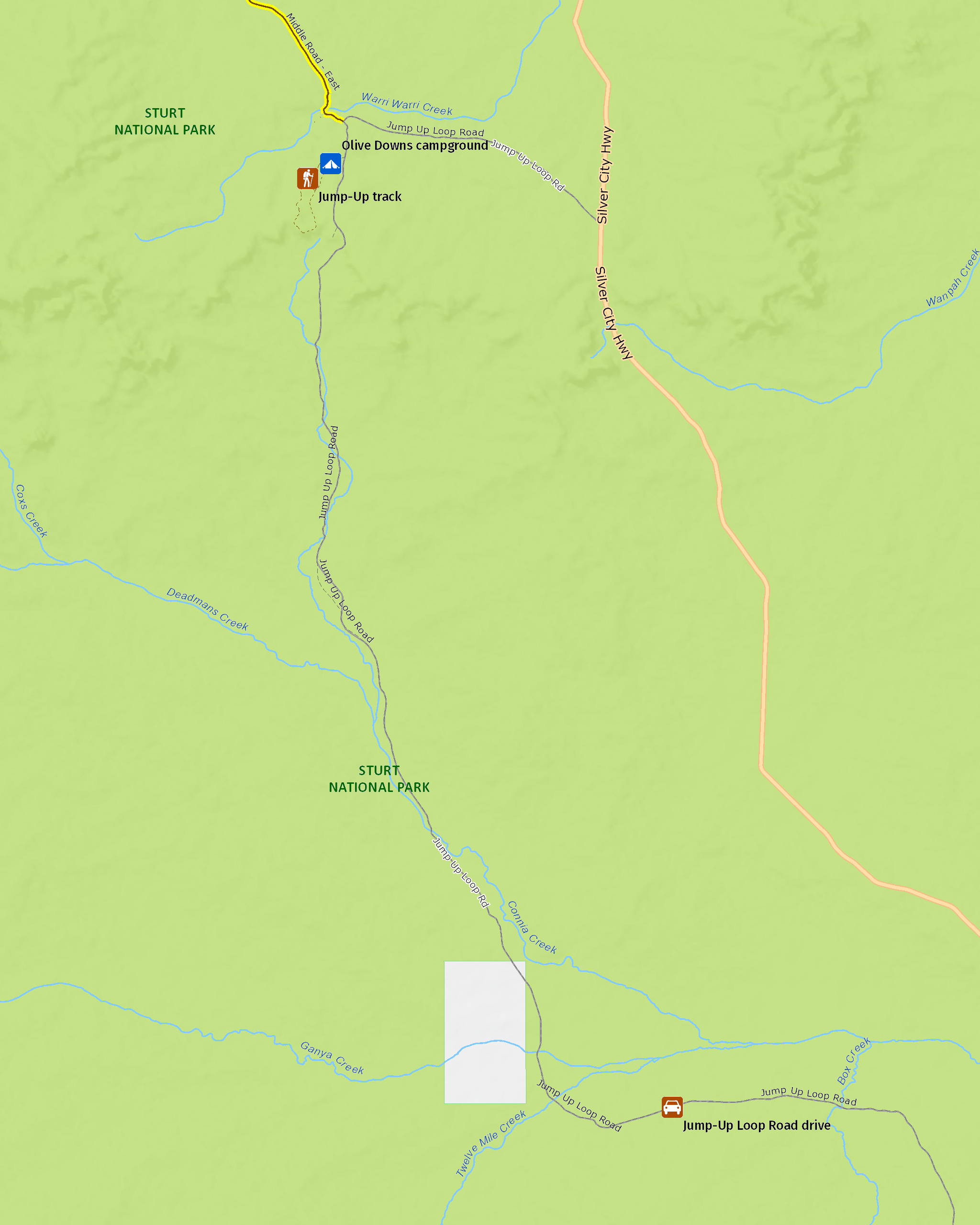Middle Road drive
Sturt National Park
Overview
In an 80km stretch, Middle Road drive takes you through the Australian outback’s diverse landscapes. Along the way, you’ll also see the famous Dog Fence.
- Where
- Sturt National Park in Outback NSW
- Distance
- 80km one-way
- Time suggested
- 3hrs
- Entry fees
- Park entry fees apply
- What to
bring - Hat, sunscreen, drinking water
- Please note
- Remember to take your binoculars if you want to go birdwatching.
- The weather in the area can be extreme and unpredictable, so please ensure you’re well-prepared for your visit. Check the weather before you set out as Middle Road drive can become boggy when it rains and may be closed.
- This attraction is in a remote location, so please ensure you’re well-prepared, bring appropriate clothing and equipment, and advise a family member or friend of your travel plans.
- The walking opportunities in this park are suitable for experienced bushwalkers who are comfortable undertaking self-reliant hiking.
- There is limited mobile reception in this park.
For anyone on a road trip through NSW, Middle Road drive has a firm place on the itinerary. Traversing Sturt National Park, this 80km touring route takes you through a remarkable landscape, some of it virtually unchanged since the likes of Charles Sturt trekked through the area.
Most people start the drive at Olive Downs Homestead, which dates back to the 1880s and was once the social hub of the area. There is also Olive Downs campground, where you might decide to stay overnight before setting off.
Along the way, you’ll pass gibber (pebble) and saltbush plains, dunes, the famous Dog Fence that runs from Queensland to South Australia, the striking Jump-Ups, the ruins of Binerah Downs Homestead, Lake Pinaroo, and the ghost tree forest caused by the water-logging of the Coolabah trees. If you wish to stretch your legs more or drive further be sure to head along Jump-Up walking track or Jump-Up Loop Road drive.
Stop at one of the watering points along the way, such as Millers Tank, where you might come across a flock of zebra finches or see a wedge-tailed eagle soaring high above.
The drive finishes near Fort Grey on the main road from Tibooburra. Here, you could choose to do Wells and Sturt's tree walking track. Or you could stay overnight at Fort Grey campground before heading home the next day.
Map

Map

Map

Map legend

Local alerts
For the latest updates on fires, closures and other alerts in this area, see https://www.nationalparks.nsw.gov.au/things-to-do/driving-routes/middle-road-drive/local-alerts
General enquiries
- National Parks Contact Centre
- 7am to 7pm daily
- 1300 072 757 (13000 PARKS) for the cost of a local call within Australia excluding mobiles
- parks.info@environment.nsw.gov.au
Park info
- in Sturt National Park in the Outback NSW region
Sturt National Park is always open but may have to close at times due to poor weather or fire danger.
-
Park entry fees:
$8 per vehicle per day. The park has coin-operated pay and display machines - please bring correct coins.
Buy annual pass.
Visitor info
All the practical information you need to know about Middle Road drive.
Getting there and parking
Get driving directions
Middle Road drive starts at Olive Downs Homestead on Jump-Up Loop Road. Turn off Silver City Highway, about 55km north of Tibooburra, to get there.
Parking
Parking is available along Middle Road drive at many of the attractions.
Best times to visit
There are lots of great things waiting for you in Sturt National Park. Here are some of the highlights.
Autumn
A great time of year to visit when daytime temperatures are pleasant and night times not too chilly.
Spring
Depending on the rainfall the park's wildflowers, including the distinctive red Sturt Desert Pea will be on show throughout the park.
Weather, temperature and rainfall
Summer temperature
Average
22°C and 36°C
Highest recorded
47.6°C
Winter temperature
Average
5°C and 17°C
Lowest recorded
-2.8°C
Rainfall
Wettest month
February
Driest month
August and September
The area’s highest recorded rainfall in one day
178.2mm
Maps and downloads
Prohibited
Camp fires and solid fuel burners
Gathering firewood
Pets
Pets and domestic animals (other than certified assistance animals) are not permitted. Find out which regional parks allow dog walking and see the pets in parks policy for more information.
If you're travelling through a national park or reserve on a public road you can have pets inside your vehicle. However, you must keep them inside your vehicle while driving through national parks or reserves. You must also comply with any conditions in the park’s plan of management, and you cannot stop to visit the park or use park facilities (unless for safety reasons, or to use publicly accessible toilets).
Smoking
NSW national parks are no smoking areas.
Visitor centre
-
Tibooburra Visitor Centre
51 Briscoe Street, Tibooburra NSW 2880 - Tibooburra Visitor Centre is always open but it's unstaffed (self service)
- 08 8091 3308
Learn more
Middle Road drive is in Sturt National Park. Here are just some of the reasons why this park is special:
A vast and varied precious landscape

Tibooburra means 'heaps of rocks' in the local Aboriginal language, and you can't miss the rocks - ancient granite tors that surround Tibooburra and line the road on the way to the park. This contrasts with the red sand of the desert on the western side of the park and with the 'Jump Ups' that rise from the plains in the central part of the park. Wherever you go in Sturt National Park, you're sure to be inspired by the dramatic changes in scenery and amazed by the true scale of the vast, arid expanse of outback.
- Jump-Up Loop Road drive A fantastic self-guided car tour of the outback country of Sturt National Park, Jump-Up Loop Road drive offers scenic desert views, historic heritage and excellent birdwatching.
- The Granites walking track Explore the geological history of Sturt National Park along The Granites walking track. See wildflowers, kangaroos and lizards as you walk over the ancient boulders.
A feral predator-free area

Locally extinct mammals are being reintroduced to Sturt National Park as part of the NSW National Parks and Wildlife Service (NPWS) feral predator-free areas project, in partnership with Wild Deserts. Over 10 years this project will reintroduce the greater bilby, crest-tailed mulgara, western barred bandicoot, greater stick-nest rat, golden bandicoot, burrowing bettong and western quoll.
Reintroducing these species, some of which have been absent for over 100 years, will play an important role in restoring the desert ecosystem in Sturt National Park. The project, funded by the NSW government, is a collaboration between NPWS and Wild Deserts (University of New South Wales and Ecological Horizons).
- Talpero lookout Visit Talpero lookout for expansive desert views and see ‘the big bandicoot’ sculpture. It’s located 2 hours from Tibooburra, near Fort Grey campground in Sturt National Park.
- Wells and Sturt’s tree walking track Retrace the footsteps of a famous explorer in the stunning and remote outback landscape of NSW’s far north-west. You'll rediscover history, see majestic red river gums and cross a dry lakebed, near Cameron Corner.
Ancient connections

Sturt National Park is the traditional land of the Wangkumara People, whose Country extended from what is now southwest Queensland and northeast South Australia down through Tibooburra to Milparinka. The Wangkumara People travelled widely throughout this large and arid land to make the most of waterholes, permanent soaks, useful plants and animals. Today there is much evidence of the Wangkumara People's connection with this land - throughout the park you might notice middens and stone relics; reminders of the role this landscape played as the giver and sustainer of life.
- Jump-Up walking track Discover the landscape of Sturt National Park along the Jump-Up walking track; you’re likely to see Aboriginal sites, wildflowers and kangaroos along the way.
- Talpero lookout Visit Talpero lookout for expansive desert views and see ‘the big bandicoot’ sculpture. It’s located 2 hours from Tibooburra, near Fort Grey campground in Sturt National Park.
A waterbird oasis

Lake Pinaroo is around 80 km north west of Tibooburra and 24km south east of Cameron Corner. It’s an ephemeral lake, meaning it floods for short periods of time and then may not hold water for several years, depending on rainfall. In 1996, it was listed as an internationally important wetland under the Ramsar Convention because of its retention of water for long periods, and the rarity of wetlands in arid NSW. Lake Pinaroo plays a crucial role in the survival of many plants and animal species, and supports large numbers of waterbirds and waders, including international migratory species and threatened species. When full, Lake Pinaroo is a stunning contrast to the dry landscapes of Sturt National Park, and you can see waterbirds like the freckled and blue-billed ducks, as well as brolgas, grey falcons and budgerigars.
Heritage values of the homestead

Historic Mount Wood Homestead is located on the oldest sheep station in northwest NSW, taken up around 1881. Listed on the State Heritage Register, it’s one of the most complete examples of a self-reliant sheep station in the region, spanning 368,385 acres. It was a hub for washing sheep wool on the long journey by camel train or cart to Wilcannia, prior to shipping. Today, the woolscour is a rare example of a complete set of wool washing equipment, and the only 19th century station-based scour in NSW to survive intact. Surviving the harsh outback, you can still see the original stone hut built in 1890, a stone homestead (1897), and an art deco-styled homestead (1935). There’s also a woolshed, shearers’ quarters, woolscour, blacksmith shop, stables, windmills and outstations. The buildings provide a fascinating window into pastoral life and changing technology over almost 100 years.
- Wells and Sturt’s tree walking track Retrace the footsteps of a famous explorer in the stunning and remote outback landscape of NSW’s far north-west. You'll rediscover history, see majestic red river gums and cross a dry lakebed, near Cameron Corner.
Plants and animals protected in this park
Animals
-

Wedge-tailed eagle (Aquila audax)
With a wingspan of up to 2.5m, the wedge-tailed eagle is Australia’s largest bird of prey. These Australian animals are found in woodlands across NSW, and have the ability to soar to heights of over 2km. If you’re bird watching, look out for the distinctive diamond-shaped tail of the eagle.
-

Emu (Dromaius novaehollandiae)
The largest of Australian birds, the emu stands up to 2m high and is the second largest bird in the world, after the ostrich. Emus live in pairs or family groups. The male emu incubates and rears the young, which will stay with the adult emus for up to 2 years.
-

Red kangaroo (Macropus rufus)
The red kangaroo is one of the most iconic Australian animals and the largest marsupial in the world. Large males have reddish fur and can reach a height of 2m, while females are considerably smaller and have blue-grey fur. Red kangaroos are herbivores and mainly eat grass.
-

Bilby (Macrotis lagotis)
The greater bilby was once widespread across arid and semi-arid regions of Australia. Today, this threatened native mammal is listed as extinct in the wild in NSW, but reintroduction efforts are seeing bilbies bounce back.
Plants
-

Sturt's desert pea (Swainsona formosa)
One of Australia’s most famous desert wildflowers, Sturt’s desert pea is found across inland arid regions of Australia, including far west NSW. One of the most easily-recognised Australian native plants, Sturt’s desert pea thrives in red sandy soil, or loam, and has vibrant red leaf-shaped flowers with a black centre, known as a ‘boss’.
-

Saltbush (Atriplex nummularia)
A hardy Australian native plant, the saltbush is a small spreading shrub that can withstand dry salty soils such as those found in the desert plains of western NSW. It is grey-white in colour and has small spear-shaped succulent leaves. It flowers from December to April.

